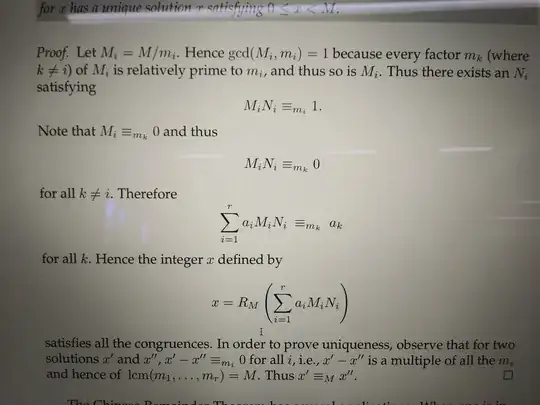I have some trouble understanding this particular proof of the Chinese Remainder Theorem.
EDIT:
As far as I understood, this is how the proof goes:
Let $M_i$ be the integer we obtain after dividing the product of modules $M$ by one of those moduli, as follows $M_i = M/m_i $. Then we have $ \gcd(M_i, m_i) = 1$ , because every factor $m_r$ of $M$ (where $r \neq i$) is coprime to all other factors of $M$ and therefore also to $m_i$. This is equivalent to saying that $M_i \equiv_{m_i} 1$.
This means that there exists a unique integer $N_i$, which satisfies $M_i N_i \equiv_{m_i} 1$ , which means that $N_i$ is the inverse of $M_i$ modulo $m_i$. At the same time, we know that every other factor $m_r$ of $M$ (where $r \neq i$) divides $M_i$, which means $M_i \equiv_{m_r} 0$. This means that it also divides $M_i N_i$ and $a_i M_i N_i$, since if it divides $M_i$ it must also divide every multiple of it (is this true or does it follow that it must also divide the inverse of $M_i$ ?), i.e. $ a_i M_i N_i \equiv_{m_r} 0 $.
Now as far as I understood from the answers below, if we build the sum $\sum_{i = 1}^k a_i M_i N_i $ and take for every summand the remainder modulo $m_r$, where $r \neq i$, then we will get $a_i M_i N_i \equiv_{m_r} 0 \ $ for every summand except the one where $ r = i$, which will then be $a_r M_r N_r \equiv_{m_r} a_r $, because $M_r N_r \equiv_{m_r} 1 $ and if we multiply that with $a_r$ we get $a_r$ as a remainder (does this $a_r$ refer to the ones in the system of congruence equations? i.e. $x \equiv_{m_r} a_r$ ? But if that is true, why can't we just use the ones from the system of congruence equations directly?). Therefore, the entire sum $\bigg( \sum_{i = 1}^k a_i M_i N_i \bigg) \equiv_{m_r} a_r$ (and not every summand) (does this also mean that if we take a different $r$ we obtain a different $a_r$ every time?).
Therefore, the solution is $ x = R_M \bigg( \sum_{i = 1}^k a_i M_i N_i \bigg)$ (how do we get to that? Where does it follow from? And can't we just add the list $a_1, a_2, ..., a_k$ instead of computing the sum?)
And the uniqueness part I don't understand at all.
Thank you for the clarifications.
